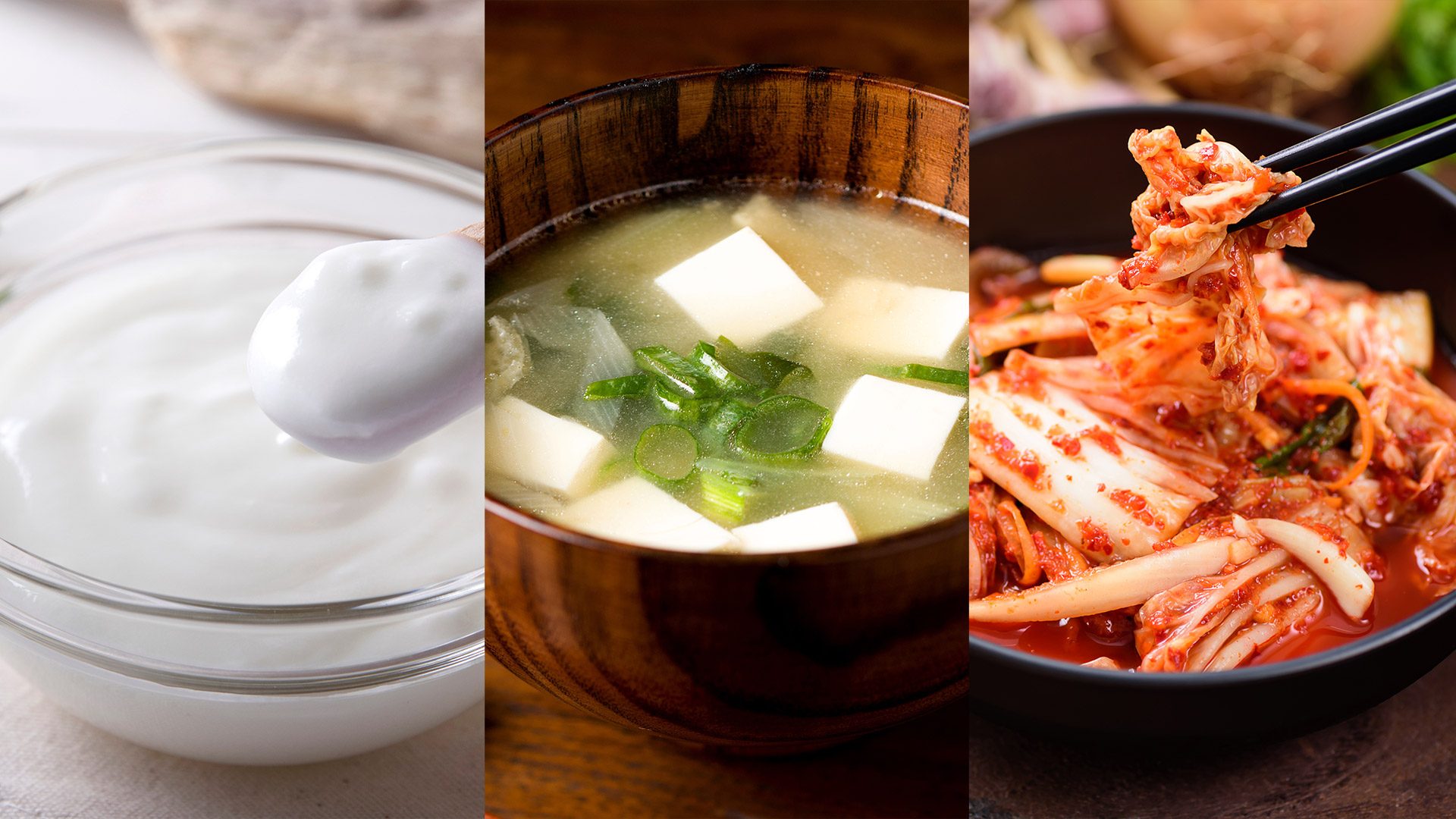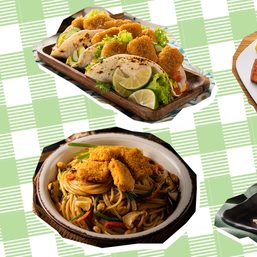SUMMARY
This is AI generated summarization, which may have errors. For context, always refer to the full article.

MANILA, Philippines – If there’s one thing you’ve gut to take care of – and not just to listen to – it’s your gut.
The “gut” refers to your gastrointestinal (GI) system, which is responsible for digestion and the absorption of nutrients, starting from your mouth, esophagus, to your stomach and large and small intestines. It’s one of the body’s most powerful units, and where most of the good and bad bacteria live.
As I got older, I began to learn that probiotics wasn’t just about drinking Yakult as a child. Probiotics go beyond just bottled drinks and supplements, and include pantry staples like yogurt, kimchi, miso, sauerkraut, and other natural foods that are packed with probiotics and incredibly beneficial to one’s health.
For those that are still not very familiar, you may be asking: What’s the deal on probiotics, and why are they so important for the gut and your overall health? What even IS the gut anyway? Sakro Space’s resident Registered Nutritionist-Dietician Bianca Dualan-Limjoco talked to Rappler to dish out everything we need to know about gut health and probiotics, in a way that’s easy to digest (pun intended)!
Keeping things ‘intestine!’ All about the gut
Each one of us has a unique microbiome in the body, found in the gut. “It consists of both good and bad bacteria, fungi, viruses, the like. While these can be found all over the body, most of them are found in the intestines. The composition of the microbiome differs from person to person and is affected by factors like genes, diet, environment, and lifestyle,” Bianca told Rappler. The microbiome contributes to your immune system and metabolic functions.
Good and bad bacteria usually co-exist in the microbiome, and this is fine, as long as there are more of the good bugs and the bad bugs are kept to a minimum. “When there are more good bugs, we are able to digest food well, absorb the raw materials from food that we need for biochemical processes, and we are also protected from accidentally consuming contaminated food,” Bianca added.
However, life happens, and when there is a slight “change in the environment” of your microbiome, this allows the bad bacteria to flourish, leaving your “gut flora” with a lack of good bacteria and making it more susceptible to imbalances and digestive symptoms.
The ultimate goal is a healthy gut, but studies on the microbiome and “its effects on health are still in its early stages, so technically is no one definition of what a healthy gut is,” Bianca clarified. A good guide is to check if you are able to digest, absorb, and eliminate wastes regularly with ease. On the other hand, the usual telltale signs of an “imbalanced, unhealthy gut” are constipation or diarrhea, excessive gas, bloating, pains, acidity, difficulty digesting food, and food intolerances.

“Imbalances in the gut usually result from low intake of fiber, fruits, and vegetables, high consumption of sugar, fats, and red meats, antibiotic use, environmental exposures, and stress. This creates a toxic environment in which good bacteria can’t multiply, but is more favorable for bad bacteria to thrive in,” Bianca said. When there are more of the bad guys in our gut, we become more susceptible to infections, since it impairs our ability to digest and absorb food properly.
“When we are able to properly digest and absorb the nutrients from the food we eat, the body can get the materials it needs to maintain all the hundreds of thousands of biochemical processes that go on inside the body. These range from neurotransmitter production to muscle formation, to breaking down toxic food substances,” Bianca said, explaining the importance of a healthy gut in relation to the body’s overall wellness.
Bianca said that the microbiome and its different strains of bacteria are currently being studied for their effects on immune function against viruses and pathogens, our susceptibility to diseases, their effects on mood and mental health, as well as their influence on blood sugar and cholesterol levels in the body.
Gut-to believe in magic
The gut-wrenching truth remains: germs can be good for you! If they’re microbes, that is.
“Having a wide variety of microbes is important for good digestion and absorption in the body because they help break down complex carbohydrates, produce some amino acids and vitamins essential to the body, and they prevent the overgrowth of harmful bacteria,” Bianca said.

These living microorganisms alter pH levels in the colon to make it “unlivable” for bad bacteria, which compete for the nutrients in your gut. “For us to maintain the presence of good bugs in the digestive tract, we should supply them with the right food source like starches and fiber,” Bianca said.
This is where probiotics come in – to “tip the scales” in favor of good bacteria, and allow them to grow and repopulate the microbiome once again. Probiotics are “live strains of beneficial bacteria that are ingested to improve gut health by adding to the diversity of the already existing microbiome.”

Probiotics aren’t just a preventive measure; they are also taken in situations where there is an imbalance in the intestines, such as food poisoning, diarrhea, or after taking antibiotics.
“Antibiotics wipe out even the good bacteria in the gut so if you have just finished taking these medicines, you should aim to repopulate the gut with probiotics,” Bianca said.
Bianca also advises that if you are an older adult or a younger child whose gut microbiome is not as strong or well-established as a healthy adult’s, it is encouraged to “influence and repopulate the gut through supplementation or added food sources.”

Probiotics can be ingested via supplements, beverages, powdered drinks, or through natural foods and drinks. Supplements may be the most convenient way to get your dose, but these typically come at a steep price, since the cost of manufacturing them is very high.
“An effective probiotic supplement will have to contain live microorganisms that remain viable throughout production, and in amounts that are high enough to be effective after ingestion,” Bianca said, so this involves a lot of research on which strains will survive processing, remain shelf-stable, will survive the stomach, reach the intestines, and assimilate well with the existing microbiome.
In fer-ness! Fermented foods to the rescue
Can’t afford probiotic supplements? No worries! Food is medicine after all, and luckily, consuming live cultures from food sources like yogurt provides more nutrition “because you are also consuming the enzymes and bioactive compounds that are byproducts of the fermentation process,” Bianca said.
Gut-friendly fermented foods have become popular for this reason, but it should be clarified that even though they contain live microorganisms, they are technically not called “probiotics” because they don’t meet the criteria to be called a probiotic.
“This doesn’t take away the many benefits we can get from consuming them. They do have live cultures that help make food more digestible and have enzymes and bioavailable compounds that remain in the food even after the microorganisms die out,” Bianca said.
The process of fermentation involves controlling microbial growth to transform both the foods’ taste and structure, making it more digestible and more absorbable by the body. The body is then able to use these materials for biochemical processes. The microbes grown during fermentation reduce toxins in the original food and produce different strains of good bacteria, acids, enzymes, and sometimes alcohols and gasses that stay in the transformed food even after the microbes are no longer present.
According to Bianca, some of the best sources of live cultures are unsweetened and unflavored yogurt, kefir, kimchi, natto, and sauerkraut. Locally, we have pickled goodies like balaw-balaw and buro, the Kapampangan delicacy of fermented rice with seafood.

Yogurt is the bacterial fermentation of milk. Kefir is a fermented milk drink (like a thin yogurt) made from kefir grains, a symbiotic culture. Kombucha is a fermented, slightly fizzy tea drink made with sugar, yeast, and bacteria; sometimes, fruit juices and other ingredients are added.
Korea’s traditional kimchi consists of salted and fermented veggies like napa cabbage, radish, leeks, carrots, and more, seasoned with gochugaro (chili powder), fish sauce, garlic, ginger, and other ingredients. Germany’s famous side dish sauerkraut is finely-cut cabbage made sour and fermented by lactic acid bacteria. Japan’s traditional miso seasoning (used for soups and dishes) is a thick paste made from fermented soybeans and salt, while natto is whole soybeans fermented with Bacillus subtilis var. natto, served with mustard, shoyu, egg, and green onion.

Keep things exciting for your gut by eating different kinds of fermented foods! Bianca says that it is beneficial to increase the diversity of the microbiome by consuming more kinds of probiotics. “This will help create a more favorable environment for the good bacteria to proliferate. Good bacteria in the intestines break down fiber to produce short chain fatty acids that then lower the pH of the environment,” Bianca said. A lower PH balance means less room for the bad guys to grow!
“At present, more studies are needed to find out actual mechanisms of action but it’s hypothesized that fermented foods imitate or work similarly to good bacteria in the gut. An example would be how yogurt cultures are able to deliver lactase to the intestines. Because of this, those with lactose intolerance can now include dairy in their diet,” Bianca added.
The key is to make your gut’s conditions favorable for the already existing good bacteria to multiply, leaving out the bad bacteria. Other ways to do this, Bianca says, is by chewing really well to help improve digestibility of food, staying hydrated, increasing your intake of beans, fruits, vegetables, and whole grains, and limiting intake of sugars, fats, and red meats.
“Keep bowel movements regular by maintaining consistent physical activity. If you are someone with intolerances to certain foods, consuming their fermented forms are a good way to reintroduce them into the diet so you can benefit from these food groups,” Bianca added.
When it comes to caring for your gut – or health in general – it helps to approach nutrition with the “add, not subtract” mindset. It’s not about restriction and lack; it’s about adding more of the good stuff into your diet and showing your gut some much-needed love. – Rappler.com
Sakro Space provides personalized nutrition programs and health & wellness consultancy services for functional nutrition. They provide nutrition therapy and counseling, focused on blood sugar, hormones, and gut health. For more information, check out Sakro Space’s Instagram.
Add a comment
How does this make you feel?





There are no comments yet. Add your comment to start the conversation.